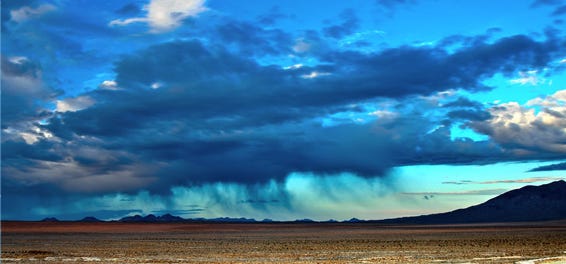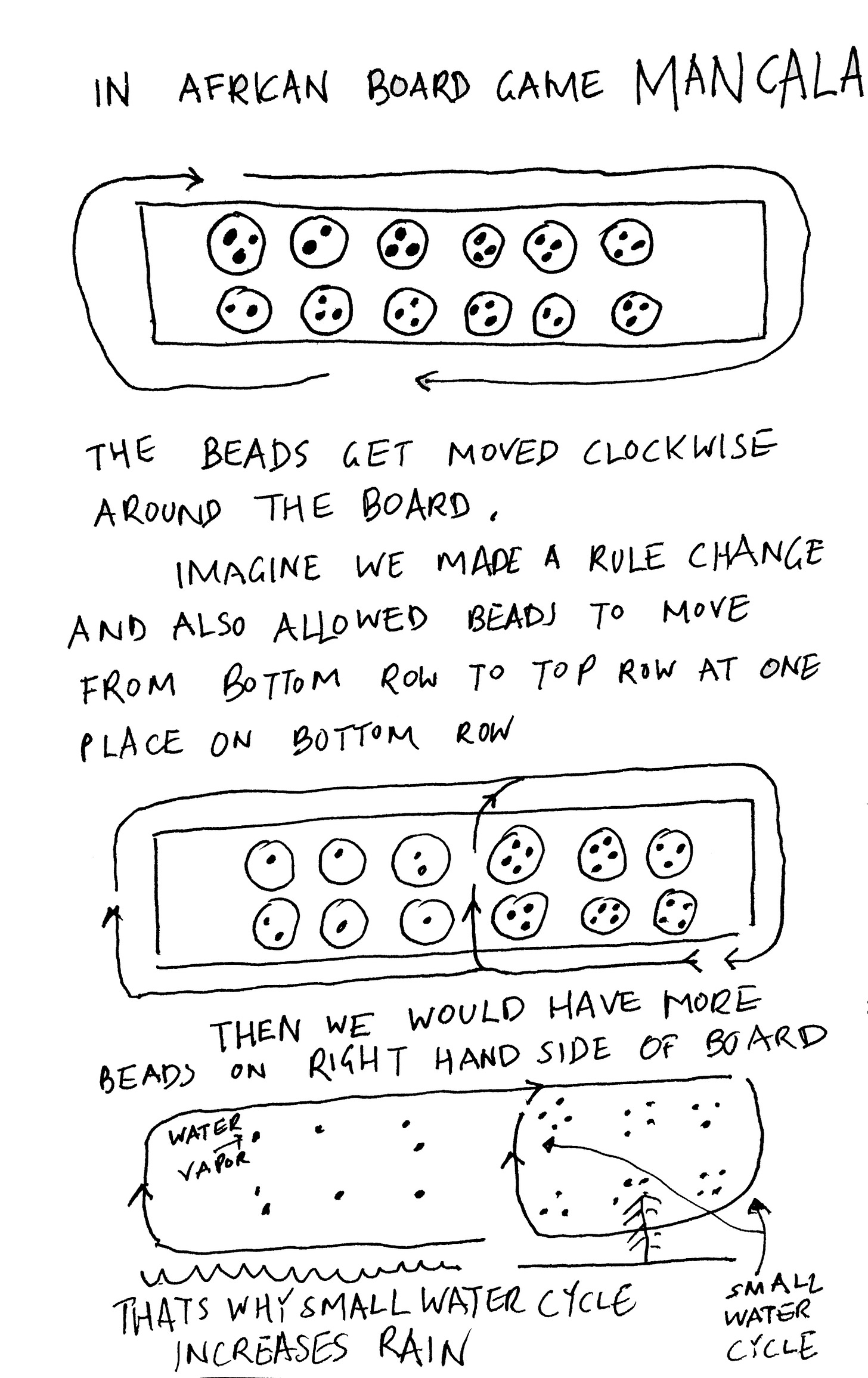What would happen to the rain if the world was all desert?
And what would happen if it was all vegetated?
Imagine our continents were just made of rock and in organic dirt. What would happen to the rain if our continents were devoid of all plant life and organic soil? Would we have the same amount of rain? Less? If it is less, that is evidence that vegetation plays a key role creating rain.
We don’t want to do this experiment in real life. But we can do this experiment on a computer.
Axel Kleidon is a German physicist turned climate scientist. Physicists have a predilection for simple models. The archetypal story is the physicist who when working to calculate the properties of a cow, said assume a spherical cow. Kleidon is known for his simple nonequilibrium thermodynamic calculations for things like the hydrological cycle of the earth, which can arrive at similar answers that more sophisticated computer climate models take a while to get to. Physicists also like to find out how systems behave in the extreme.
Kleidon, along with his colleagues Klaus Fraedrich and Martin Heimann, decided to ask its computer model about some of these extreme simplified situations, how the rain in the world would behave if continents were all desert, and if they were all vegetation. In the all vegetation world, they found that land evapotranspiration more than triples. The land evapotranspiration triples, because now the land is able to absorb more of the rain, and it then able through the trees to transpire it upwards. In the simulation the rain on the land doubles. The small water cycle (precipitation recycling) thus doubles. Not all the land evapotranspiration becomes rain on the land, some of it gets blown out to sea where it creates rain there.
A forest is darker than a desert, so it absorbs more heat. Deserts reflect heat back immediately so they are hotter during day and colder at night. Forests hold onto heat longer, releasing some of it at night. Forest evapotranspiration during day also cools land, in the same way sweat evaporating cools your body. The forested land temperature in their models turns out to be cooler by 8 degrees Celsius in the day.
The effect on the water cycle is different in different parts of the world. In their 1999 paper A green planet versus a desert world; estimating the maximum effect of vegetation on the land surface climate Kleidon and his colleauges write “Considerably more water from the soil is recycled in the ‘green planet’ simulation, with the peaks located in the semiarid tropical regions of Africa, South Asia and South America. This increased depletion is directly linked to enhanced evapotranspiration from these regions during dry seasons. Large scale patterns of increase in evapotranspiration can be found over most continental surfaces. Being in the order of 2–4 mm day−1 , they form a substantial increase in evapotranspiration. In temperate regions, these differences are concentrated in the summer months while in most humid tropical regions the differences persist throughout the year. As a result of the substantial increases in evapotranspiration over the continental regions, the atmosphere is moister over most parts of the summer hemisphere and the tropics. A few regions over the ocean show a decrease in atmospheric moisture as a result of differences in the circulation. Precipitation generally increases over continental regions in a similar magnitude as evapotranspiration. Strongest differences are found in the Inter Tropical Convergence Zone (ITCZ), especially over the Monsoonal regions of Southeast Asia/India. In contrast to the persistent increase of evapotranspiration in tropical regions, precipitation mainly increases during the wet season. In temperate regions, precipitation increases during the summer months. The differences in evapotranspiration and precipitation also modify the general hydrology of the land surface……….. Precipitation is more than doubled for most river basins in tropical and subtropical regions (e.g., Amazon, Congo, Nile, Parana, Ganges) while the relative differences are smaller for arctic rivers (e.g., Mackenzie, Yenissey). River basin discharge is not reduced in all cases in the ‘green planet’ (e.g., Parana, Niger, Ganges) since the increase in precipitation is larger than the increase in evapotranspiration.”
They write “In this study we investigated the question to which extent vegetation can affect climate. This was done by a new approach where we used the benefits of coupled biome-climate models (which emphasize the fact that land surface parameters should not be treated as independent parameters since they represent different aspects of vegetation) and combined it with two climate model simulations at the extreme stages of ecological succession. By comparing the two extreme climates, we were then able to obtain an estimate for the maximum effect of vegetation on the land surface climate and the global water cycle. Most of the climatic effects could be understood by the differences in continental evapotranspiration, which subsequently affect the surface energy balance and the atmosphere. We may speculate that the albedo effect plays a dominant role during the wet season (since water storage is of minor importance during this period), while the rooting depth effect is more important during the dry season.”
If the continents were initially devoid of all life, how would vegetation go about colonizing it? How would the rain increase?
Initially when rain falls on these continents, flash flood behavior will happen, as the rain rushes downhill without any vegetation and soil to slow it down. The amount of rain would exponentially decay towards the interior of the continent, because when it rains near the coast, water vapor disappears from the air. When the air gets blown further inland, there is less water vapor to make rain.
Rain might collect in some geomorphological indentations, and in those areas we would more likely have fungi, plant life and soil building. Those green patches then expand in area over time. They will be able to absorb more rain, and also evapotranspire more water. Then as the air gets blown inland, there is more likelihood of there to be rain, as it is now made up of both ocean moisture and land evapotranspiration. We would expect vegetation to begin nearer the coastline where the wind blows toward, and then over time as the small water cycle increases, as more moisture hopping happens, that vegetation moves towards the interior of the continent.
One analogy I came up to think about the change in behavior of the rain, is to think of a Mancala board, where the stones are shuffled around to move clockwise. If the stones could move upward at a point on the bottom of the board, before it has moved all the way to the left, then we would get a lot more stones on the right side of the board.
Another analogy is to think about this is trees as traffic cops redirecting the flow of the water. If there were no traffic cops, the rain on the land, would mainly become runoff to the ocean. But with traffic cops, water gets redirected inland.
Rain is dynamic. It is affected by vegetation. Rain on our continents evolve, in a dance of biome and climate.
………………….
This is a reader supported publication
References
Fraedrich K, Kleidon A, Lunkeit F. A green planet versus a desert world: estimating the effect of vegetation extremes on the atmosphere. J Clim (1999)
Kleidon, Axel, and Maik Renner. "Thermodynamic limits of hydrologic cycling within the Earth system: concepts, estimates and implications." Hydrology and Earth System Sciences 17, no. 7 (2013): 2873-2892.
KleIdon, Axel. "Entropy production by evapotranspiration and its geographic variation." Soil and Water Research 3, no. S1 (2008): S89-S94






Thanks for link . Yeah the cloud feedback processes are complicated. Currently there is a +- of 2 degree Celsius in climate models because of uncertainty around clouds
I just stumbled upon this paper "Reimagining Earth in the Earth System" ( https://agupubs.onlinelibrary.wiley.com/doi/10.1029/2023MS004017 ) and it seems like an interesting walk through historical perceptions of forest-climate relationships, both in seeking to deforest and reforest land.